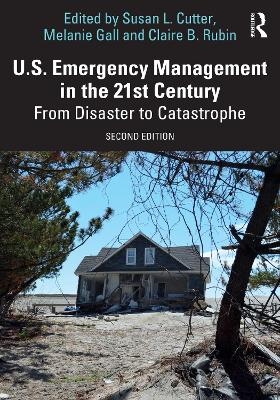
U.S. Emergency Management in the 21st Century
Routledge (Verlag)
978-1-032-97050-9 (ISBN)
- Noch nicht erschienen (ca. März 2025)
- Versandkostenfrei
- Auch auf Rechnung
- Artikel merken
The effects of climate change and compounding hazards are pushing natural and social systems to their breaking points. Our understanding of hazards and disasters is rapidly changing, and it is unclear as to whether our existing management systems are adequate to adapt to the disasters already present let alone those occurring during the next decade. Thoroughly updated to include the latest research in the hazards and disasters field, U.S. Emergency Management in the 21st Century continues the tradition of giving readers access to exemplary case studies drawn from a wide variety of hazards as well as academic and applied fields. The second edition has features nine new chapters, highlighting transitions from the status quo to untested operational environments.
NEW TO THE SECOND EDITION
Discussion on COVID-19 pandemic and the lacking local capacity for preparedness with an eye towards future public health emergencies.
“Forgotten” hazards (heatwaves and coldwaves) in Phoenix, AZ and Buffalo, N.Y
Emerging challenges in hurricane preparedness and response with rapid intensification.
Rapidly changing cyles of too little or too much water in the west resulting in water storage emergencies.
Cascading hazards and out-of-sight water crises in the Southwest
Extreme and heavy precipitation resulting in flash flooding in Tennessee, New York City, Montana, and Vermont.
Response and recovery from hazardous materials transportation (East Palestine, Ohio train derailment)
Updated conclusion describing divergence between federal, state, and local emergency management concerns and priorities.
A new co-editor, Melanie Gall, recognized for her teaching and scholarship on natural hazards and emergency management.
Accessible and written by experts in emergency management research and practice, U.S. Emergency Management in the 21st Century remains an indispensable textbook on disaster case studies, emergency management policy and practice. An essential resource for students, an interested public, and professionals alike.
Susan L. Cutter is Carolina Distinguished Professor at the University of South Carolina where she co-directs the Hazards Vulnerability and Resilience Institute. She is an internationally recognized scholar in the field producing more than 13 books, and 200 peer-reviewed articles and book chapters. She has led post-event field teams across a range of events from September 11th World Trade Center attack, the Graniteville, SC train derailment, to Hurricane Katrina and Hurricane Sandy, and the SC Flooding of 2015. As an educator, she has trained and mentored more than 75 graduate students enabling the next generations of hazards scholars and practitioners. Recipient of many distinguished awards, Dr. Cutter is an elected member of the American Academy of Arts and Sciences, and an elected member of the National Academy of Sciences, the nation’s highest honors. Melanie Gall is a certified floodplain manager and co-directs the Center for Emergency Management and Homeland Security at Arizona State University. She operates the Spatial Hazard Events and Losses Database for the United States which provides the most comprehensive data on the monetary and human impacts of hazards accessible to the public. Trained as a hazards geographer, her expertise lies in risk metrics (e.g., disaster losses, indices, risk assessments), hazard mitigation and climate change adaptation planning as well as environmental modeling. The applied nature of hazards research allows her to work closely with emergency management agencies from local to federal levels. She has conducted post-disaster field work in Mozambique, Haiti, and in the United States. Her publications appeared in journals such as Nature Climate Change, Bulletin of the American Meteorological Society, and Natural Hazards Review. Claire B. Rubin has almost 40 years of experience in the field of emergency management, having worked as an independent researcher, academic, practitioner, and consultant. As a consultant, she has worked for many organizations — private, non-profit, and governmental — over the past 38 years. Her work includes basic and applied research; the development and presentation of training programs; and the creation and operation of various information dissemination and utilization projects. From 1998-2014, Ms. Rubin was affiliated with the Institute for Crisis, Disaster, and Risk Management at The George Washington University in Washington, D.C. She was a research associate and adjunct faculty. In recent years, she has been a contributing writer for Emergency Management Magazine and has hosted the blog RecoveryDiva.com. In 2016, Rubin worked for the Arlington County Office of Emergency Management as a part-time staff member for a special project on outreach to houses of worship. She has published about 100 articles and given many lectures at professional conferences. Rubin is the co-founder and former Managing Editor of The Journal of Homeland Security and Emergency Management.
1. Challenges - Recent and Future 2. Emerging Tipping Points in Policy and Practice 3. Hard Lessons in the Human Nature of Pandemics: COVID-19 Response and Recovery in the United States 4. Transporting Toxics 5. Rural Tornado Outbreaks: Inequities in Exposure, Response, and Recovery 6. Wildfires: Firestorms, Smoke, and Unintended Consequences 7. From Phoenix to Buffalo: Experiences with Extreme Temperature 8. Not Enough Water: Drought Emergencies in the American Southwest 9. Climate Whiplash: Close Calls in Managing Water in the American West 10. Heavy Precipitation and Flash Flooding: Lessons from Vermont, Tennessee, Montana, and New York City 11. Hurricanes: Challenges in an Era of Rapid Intensification and Previously Unthinkable Disasters 12. Foreshadowing the Future: What is Looming on the Horizon? 13. Conclusion 14. About the Authors
| Erscheint lt. Verlag | 31.3.2025 |
|---|---|
| Zusatzinfo | 10 Tables, color; 16 Line drawings, color; 28 Halftones, color; 44 Illustrations, color |
| Verlagsort | London |
| Sprache | englisch |
| Maße | 178 x 254 mm |
| Themenwelt | Naturwissenschaften ► Biologie ► Ökologie / Naturschutz |
| Sozialwissenschaften ► Politik / Verwaltung ► Staat / Verwaltung | |
| ISBN-10 | 1-032-97050-2 / 1032970502 |
| ISBN-13 | 978-1-032-97050-9 / 9781032970509 |
| Zustand | Neuware |
| Haben Sie eine Frage zum Produkt? |
aus dem Bereich


